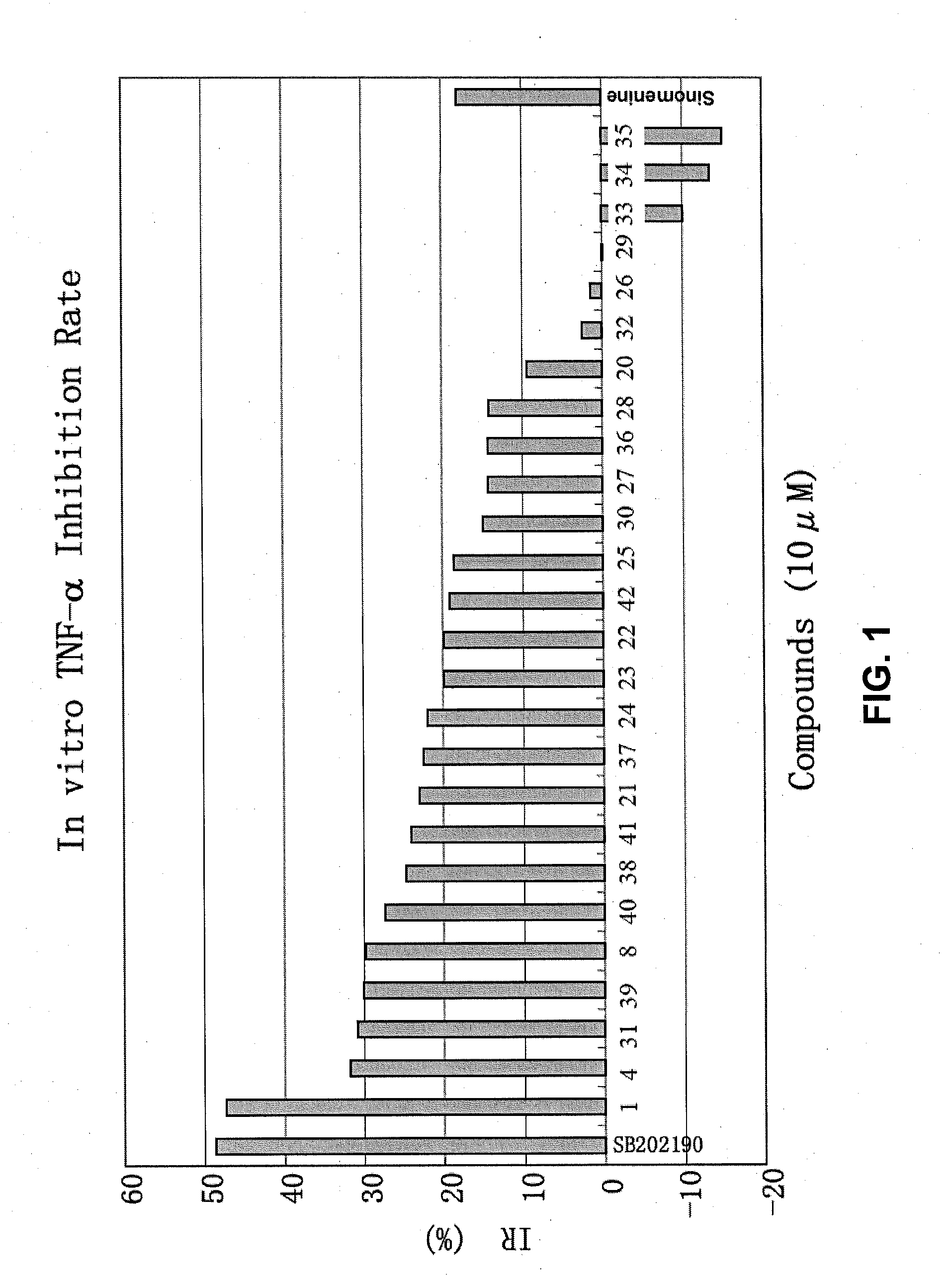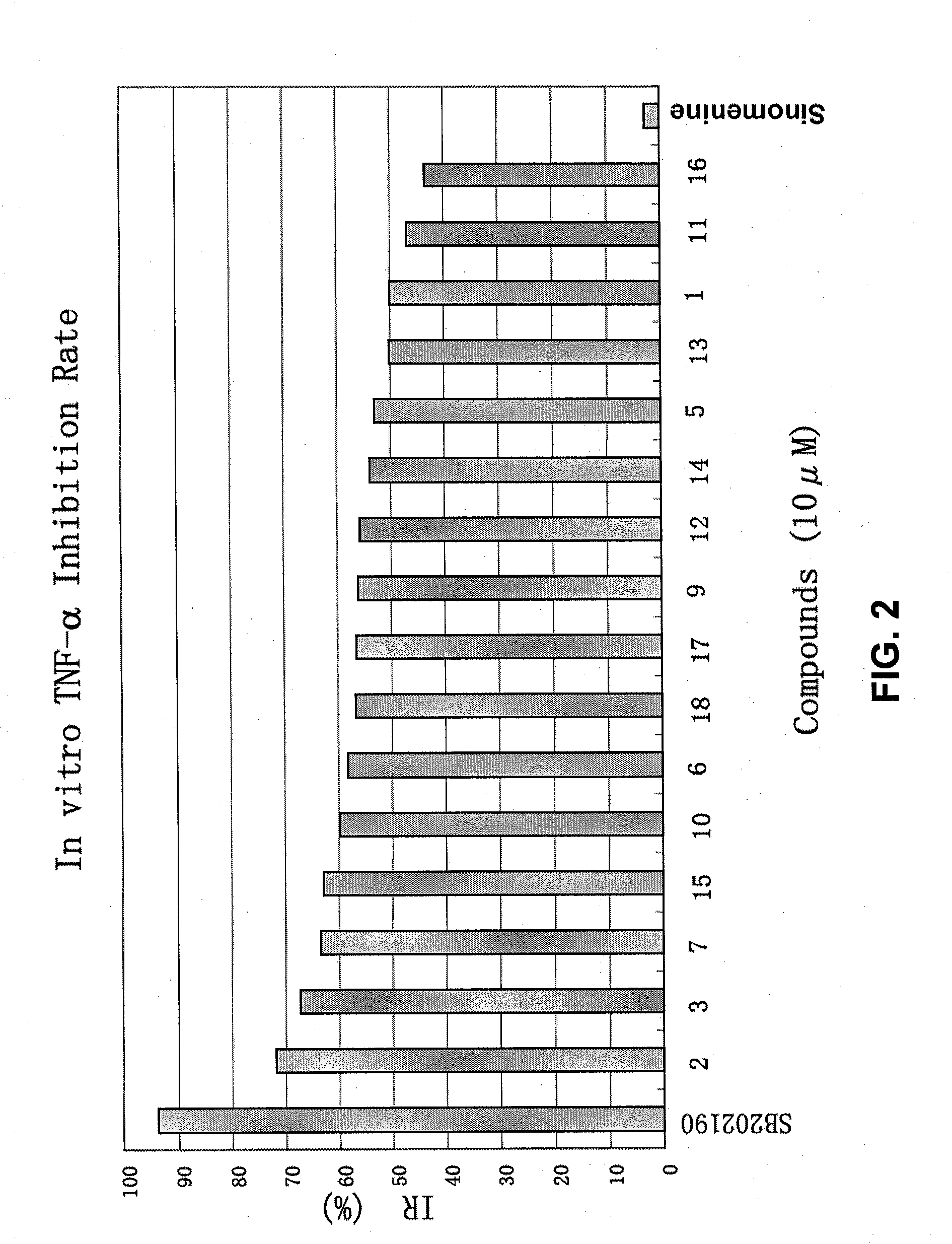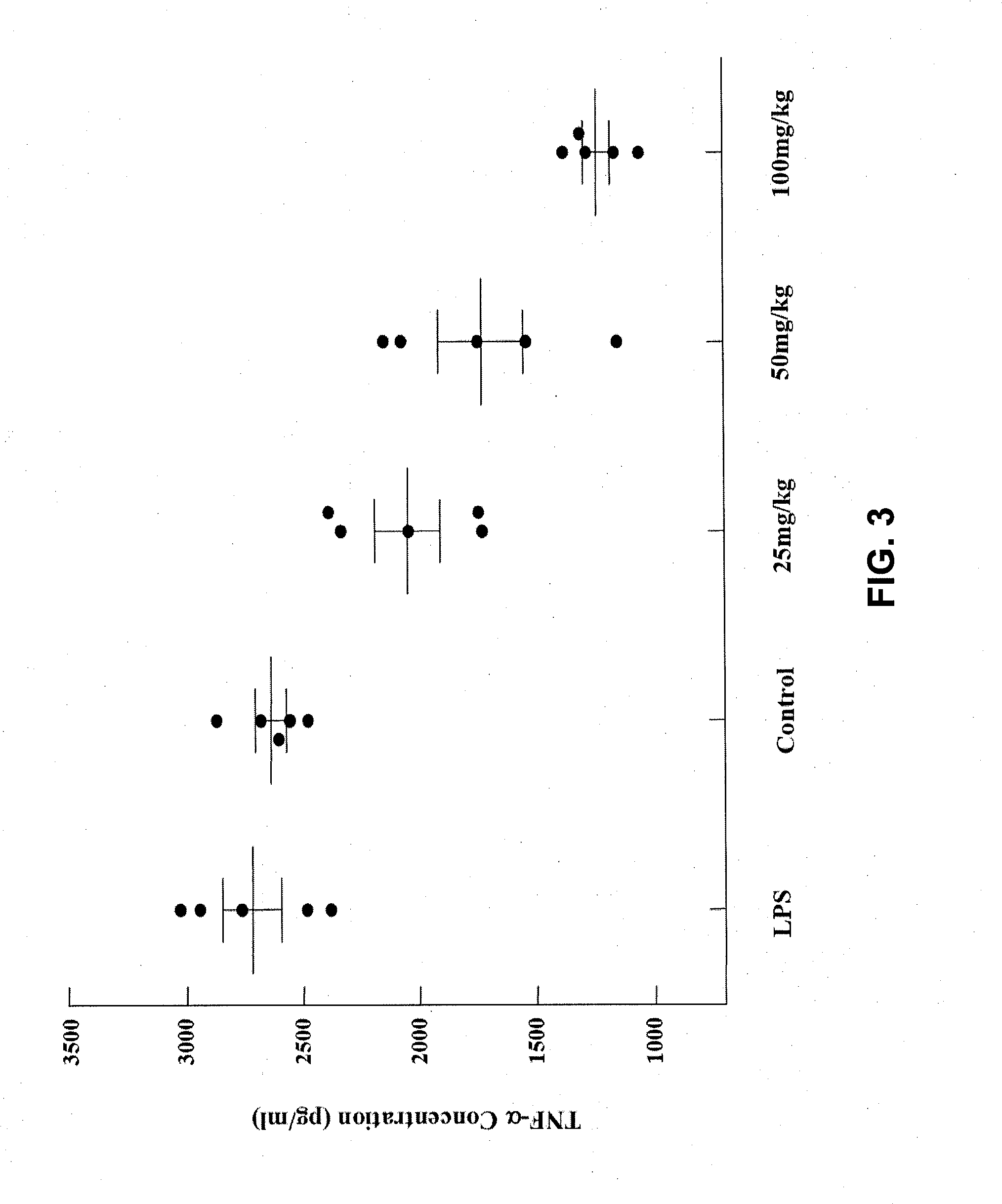Sinomenine derivatives, synthetic methods and uses thereof
- Summary
- Abstract
- Description
- Claims
- Application Information
AI Technical Summary
Benefits of technology
Problems solved by technology
Method used
Image
Examples
example 1
[0132]
[0133]Compound 20 (0.615 g, 1.96 mmol) and dichloromethane (10 mL) are added in a 50 mL pear-shaped flask. The mixture is stirred at room temperature. P-tolyl mercaptan (0.368 g, 2.96 mmol, 1.5 equiv.) is added. The stirring is continued after the addition until TLC shows the disappearance of the starting material. To work up, petroleum ether is added to the reaction solution to precipitate the product, which is collected by suction filtration, washed with petroleum ether, and evaporated to give a final product (0.68 g, 79%).
[0134]M.p. 224-225° C. (dec.); [α]D26=7.0 (c 0.50, CHCl3—CH3OH=10:1); 1H NMR (DMSO-d6, 400 MHz): δ 9.47 (1H, s), 8.18 (1H, s), 7.57 (2H, d, J=8.0 Hz), 7.25 (2H, d, J=7.6 Hz), 7.02 (1H, d, J=8.4 Hz), 6.67 (1H, d, J=8.0 Hz), 6.27 (1H, d, J=2.0 Hz), 4.47 (1H, s), 4.18 (1H, d, J=15.2 Hz), 3.53 (3H, s), 3.11-3.18 (1H, m), 2.99 (1H, brs), 2.39 (1H, d, J=15.2 Hz), 2.33 (3H, s), 2.24-2.32 (1H, m), 1.93 (3H, s), 1.80 (1H, td, J=4.4, 10.8 Hz), 1.62-1.76 (2H, m); 13C...
example 2
[0135]
[0136]Compound 20 (1.0 g, 3.19 mmol) and dichloromethane (30 mL) are added in a 50 mL pear-shaped flask. The mixture is cooled in an ice bath. 4-trifluoromethylbenzene mercaptan (0.62 g, 3.51 mmol, 1.1 equiv.) is added. The stirring is continued after the addition, and the reaction is allowed to warm up to room temperature until TLC shows the disappearance of the starting material. To work up, the reaction solution is evaporated to dryness, and the residue is purified on a column to give a white solid (1.21 g, 77%).
[0137]M.p. 240-241° C. (dec.); [α]D27=−19.9 (c 0.60, DMSO); 1H NMR (DMSO-d6, 400 MHz): δ 9.53 (1H, s), 8.24 (1H, s), 7.82 (2H, d, J=8.4 Hz), 7.75 (2H, d, J=8.0 Hz), 6.96 (1H, d, J=8.4 Hz), 6.68 (1H, d, J=8.0 Hz), 6.19 (1H, d, J=2.0 Hz), 4.79 (1H, s), 4.19 (1H, d, J=15.2 Hz), 3.53 (3H, s), 3.18 (1H, d, J=2.8 Hz), 3.03 (1H, s), 2.41 (1H, d, J=15.2 Hz), 2.31-2.39 (1H, m), 2.16 (3H, s), 1.84-1.97 (1H, m), 1.68-1.78 (2H, m); 19F NMR (CDCl3, 400 MHz): δ-59.69; IR (KBr): v...
example 3
[0138]
[0139]Compound 20 (1.0 g, 3.19 mmol) and dichloromethane (30 mL) are added in a 50 mL pear-shaped flask. The mixture is stirred in an ice bath. A solution of 3-bromobenzene mercaptan (0.36 mL, 3.51 mmol, 1.1 equiv.) in dichloromethane (15 mL) is added dropwise. The stirring is continued after the addition. The solution is allowed to warm up to room temperature and stirred until TLC shows the disappearance of the starting material. To work up, the reaction solution is evaporated to dryness, and the residue is purified on a column to give a white solid (1.25 g, 78%).
[0140]M.p. 205-207° C. (dec.); [α]D27=14.7 (c 0.50, DMSO); 1H NMR (DMSO-d6, 400 MHz): δ 9.50 (1H, s), 8.20 (1H, s), 7.90 (1H, t, J=1.6 Hz), 7.65 (1H, d, J=8.0 Hz), 7.53 (1H, d, J=8.0 Hz), 7.37 (1H, t, J=8.0 Hz), 7.00 (1H, d, J=8.4 Hz), 6.67 (1H, d, J=8.4 Hz), 6.23 (1H, d, J=2.0 Hz), 4.66 (1H, s), 4.18 (1H, d, J=15.2 Hz), 3.52 (3H, s), 3.15 (1H, d, J=2.8 Hz), 3.01 (1H, s), 2.40 (1H, d, J=15.2 Hz), 2.28-2.36 (1H, m), 2...
PUM
| Property | Measurement | Unit |
|---|---|---|
| Temperature | aaaaa | aaaaa |
| Time | aaaaa | aaaaa |
| Time | aaaaa | aaaaa |
Abstract
Description
Claims
Application Information
 Login to View More
Login to View More - R&D
- Intellectual Property
- Life Sciences
- Materials
- Tech Scout
- Unparalleled Data Quality
- Higher Quality Content
- 60% Fewer Hallucinations
Browse by: Latest US Patents, China's latest patents, Technical Efficacy Thesaurus, Application Domain, Technology Topic, Popular Technical Reports.
© 2025 PatSnap. All rights reserved.Legal|Privacy policy|Modern Slavery Act Transparency Statement|Sitemap|About US| Contact US: help@patsnap.com



